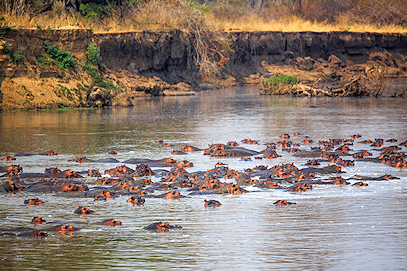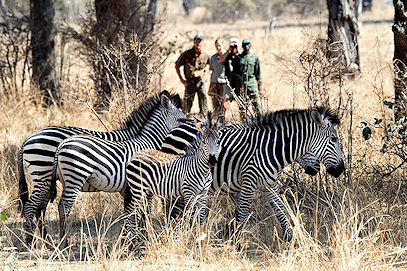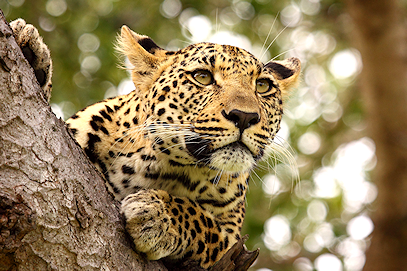South Luangwa National Park
The park lies within the Luangwa Valley, whose floor, for the most part, is gently sloping and well-wooded with isolated, broken ridges and a flat alluvial plain. The Luangwa River inundates its floodplain periodically, usually in February, and after a flood, sometimes changes its course, leaving oxbow lakes along the old channel. It offers some fine off-the-beaten-track safaris in the African country of Zambia.
Need Advice?- Home
- >>
- African Travel
- >>
- Zambia
- >>
- South Luangwa National Park
Overview
The park is large and the most accessible national park in the Luangwa valley. Its animal concentrations are among the highest in Africa, and it is a favorite destination among birdwatchers.

South Luangwa National Park has vibrant and varied wildlife. Still, commercial poaching has brought the once-widespread black rhinoceros population to regional extinction, and elephant numbers have also declined. Hippos, buffaloes, warthogs, the endemic Thornicroft's giraffe, bushbuck, kudu, eland, reedbuck, waterbuck, puku, roan, and Lichtenstein's hartebeest are just a few of the species of game that may you will encounter. It is one of the few national parks in Africa that allow night safaris.
Reasons to Visit
Atypical Antelope
When visiting South Luangwa, look for the puku and red lechwe, neither of which you could encounter in South Africa nor Namibia. They are primarily found in wet grasslands and eat mostly aquatic plants. They are also largely unknown to anyone who has yet to go to the area.
Click, Click, Click
The park is any photographer's dream. The landscapes, cloudscapes, and wildlife are mesmerizing. The blues of the Luangwa River against the golden sandbanks and the lush green wetlands make for exceptional photo opportunities, so be sure to pack extra batteries and a dust cover for your gear.
African Wild dog
Several packs of the African Wild dog or African-painted dogs inhabit South Luangwa. The park is one of the best places to view these endangered canines. It will surely be a highlight if you spot one of these elusive predators on your safari.
Experiences to Savor
As one of Zambia's most sought-after national parks, you'll savor every moment spent in this unadulterated wilderness. Stand-out experiences range from participating in the original walking safari to premium game viewing opportunities.

Strange Rocks
The Luangwa River is beautiful on its own, but ever so often, driving up to it, you are sure to see some rock formations that weren't there the day before. Upon closer inspection, it becomes clear that the moving rocks are a massive herd of hippos.
Walking Safaris
The walking safaris at South Luangwa National Park are among the best in the world. Walking along the tracks of the various animals that inhabit the area, over the grass plains, and through the shallower river channels allows guests to connect with nature truly.
Tree-top Scouting
Leopard sightings in the park are one of the most sought-after by guests. Strangely enough, birders often find these marvelous creatures lying calmly in the trees, keeping an eye out from their elevated position – so be sure to scout for them.FAQ
Useful Travel Info
By Air
We meet guests traveling to South Luangwa at OR Tambo in Johannesburg and assist them in transferring to the international flight to Kenneth Kaunda International Airport in Lusaka. Upon arrival, guests will board a domestic or charter flight to Mfuwe Airport, which was constructed specifically for tourists to the park.
By Road
Upon arrival at Mfuwe Airport, guests will travel to their lodgings in a private, air-conditioned vehicle. Although the Mfuwe Gate lies only 20km from the airport, lodges are spread across the park, and the drive through the park can take a couple of hours over rougher terrain. It is, however, an excellent opportunity for game viewing.
When traveling to Zambia, the consensus is to visit when it is dry, with the only exception being if your main aim is to visit Victoria Falls, which is at its best at the end of summer and autumn, from February to May. The dry season starts in May and ends in October, making May an ideal month for experiencing wildlife and falls.
During the rainy season from December to April, the terrain becomes a dense jungle, and animals are hard to spot through the thick vegetation. Lodges try to stay open as long as they can for birders, and some remain open throughout the year, but the rains make a lot of the areas in the park inaccessible.
In 1904, the Luangwa Game Park was proclaimed on the river's eastern bank. By 27 May 1938, three parks were created in the valley: North Luangwa Game Reserve, Lukusuzi Game Reserve, and South Luangwa Game Reserve. South Luangwa Game Reserve corresponds roughly with today's South Luangwa National Park - except for adding Chifungwe Plain. South Luangwa National Park was established on 15 February 1972 when legislation turned all the game reserves into national parks. Norman Carr pioneered the walking safari here and was one of the reserve's first rangers.
Anthropogenic history in the park dates back at least 2 million years ago. Archeologists found Early, Middle, and Late Stone Age stone tools here, and evidence of early agriculture appeared around 400 AD. In more recent history, the Portuguese founded the first settlement, "Zumbo," on the eastern banks of the Luangwa River in 1546. It was the first Portuguese settlement in what is now Zambia. In the 19th century, European explorers such as the Portuguese Antonio Gamitto and the famous Dr. David Livingstone traversed Luangwa.
The abundance and diversity of wildlife in South Luangwa National Park rival the finest reserves in the world. Lions are the most common predators; large prides are relatively easy to spot. The park is possibly the best place to find leopards, as their consecration of one leopard for every 2.5 km² is twice that of Kruger National Park. Thus, you will likely encounter this elusive predator and the spotted hyena on a night drive. The elusive wild dogs do occur but are rarely seen. There are only a handful of cheetah sightings in a year. Impala is by far the most common antelope, followed by the puku.
Thousands of hippopotamuses congregate in the Luangwa River. Elephants are plentiful and not too skittish around people. Buffalo herds more than a hundred strong are present. The only Big Five animal missing is the rhinoceros, which has sadly been hunted and poached into extinction. Unique subspecies such as Thornicroft's giraffe, Cookson's wildebeest, Crawshay's zebra, and defassa waterbuck attract wildlife enthusiasts from around the globe. The tropical forest and dry plains are home to hundreds of bird species. During the rainy summer, yellow-billed storks with pink breeding plumage fill the trees, and migrants are abundant. A few notable species include the African skimmers, giant eagle owls, and carmine bee-eaters.
The park stretches over two ecoregions: Zambezian and Mopane woodlands are most prominent on the lower parts of the valley, while the Southern Miombo woodlands cover the higher areas. Both regions are classified as woodland savanna, and grassland can be found within these areas. Closer to the river, patches of floodplains are prevalent, which are extremely important for the river ecosystem, including the larger animals, such as the crocodile and hippopotamus.
The Luangwa River that winds through the park – one of the main tributaries of the Zambezi River – generally floods in the rainy season and is one of the largest in Zambia. It is the habitat of the largest concentration of hippos in the world. The tributaries of the Luangwa River are dry throughout most of the year, but you can follow the giant mahogany trees found on their banks to the park's main river. The key to the park's lush and diverse flora lies in the volcanic, nutrient-rich, and even salt pans such as the Kakumbi pan in the Nsefu region.
South Luangwa is a premier safari destination with a variety of safari options. Bush walks, accompanied by experienced guides through the unspoiled wilderness, allow visitors a rare glimpse into the natural habitat of the wildlife. On boating safaris in the green season, you can sit back and relax while enjoying the lush scenery. Aquatic mammals such as the hippopotamus and various reptiles such as the crocodile are seen up close. Birding safaris offered at Luangwa are designed to meet the particular needs of birding enthusiasts - ornithologists or expert birding guides accompany these unique safaris in Africa.
Game drives are an excellent way to view larger animals and explore more of the park's lush landscapes. Some lodges offer night drives for a rare glimpse into the lives of nocturnal animals (many of which are nocturnal hunters). Guests can take a break by visiting the tranquil Bush Spa for various beauty and relaxation treatments using traditional ingredients. Visitors can experience cultural immersion at Kawaza Village, situated just outside the park. In 2000, the village received the British Guild of Travel Writers' Silver Otter Award for the "Best Overseas Tourism Project."









